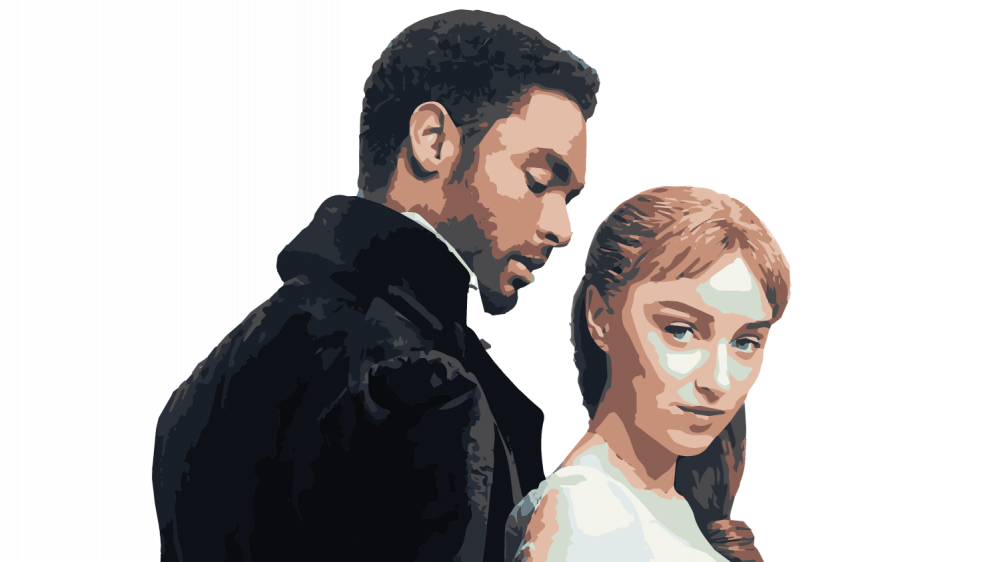Based on the book series of the same name, “Bridgerton” follows the titular family in Regency-era London during the “social season,” the period during which young women came out into society in search of a husband. The first season of “Bridgerton” adapted the first book of the series “The Duke and I,” following the eldest daughter Daphne Bridgerton’s (Phoebe Dynevour) first social season and her encounters with the Duke of Hastings Simon Basset (Regé-Jean Page).
When the season first begins, Daphne is a favorite of Queen Charlotte and thought to be the most incomparable woman. When her eldest brother Anthony (Jonathan Bailey) drives away all of her suitors except for the unpleasant Lord Berbrooke, she is desperate for the chance to regain society’s attention in the hope of finding someone she truly loves.
Luckily for her, the new Duke of Hastings is equally desperate to stop the mothers from trying to marry him to their daughters, and so they cook up a scheme: they will pretend to be courting one another to make Daphne more desirable and Simon unavailable.
At the same time, there are a number of other plotlines running throughout the season, such as the new anonymous columnist Lady Whistledown (voiced by Julie Andrews), the other Bridgerton children’s struggles with love and their place in society and the new arrival of another upper-class family named the Featheringtons.
One of the major flaws of the series is that it tries to have too many stories in one season. With eighteen main characters and even more recurring characters, it’s impossible for each character to be fully fleshed out, have their own story arc and play into the main plotlines of the season. The series does its best, but can’t quite manage it all.
Despite including too many plotlines, the storylines are captivating and, for most of them, well thought out. If a viewer finds themselves disliking one plot, they don’t have to wait long for another one to take the focus.
The series is consistent with the main plot of the first season, however, about Daphne and Simon. Their relationship with each other grows faster than in a typical romance plot because they experience a nonstandard relationship twist in the middle of the season.
With so many characters, it makes sense that some of them feel irrelevant to the series. The last episode features another Bridgerton’s arrival, but viewers are more likely to question why the showrunners felt the need to introduce her at the end of the season, or even at all. Of the Bridgerton children themselves, only Daphne, Anthony and Eloise (Claudia Jessie) are given consistent storylines throughout the season, while two of the brothers begin getting storylines in the latter half.
The series tries to encourage female empowerment and diversity, but their results fall a little short at times. While Bridgerton daughter Eloise often discusses her dreams of independence and praises the anonymous columnist Lady Whistledown for her own freedom, most of the female characters of the season still operate within the bounds of what is socially acceptable for them to do, regardless of their personal desires.
In regards to race, creator Chris Van Dusen purposely included people of color into the series, with the idea that Queen Charlotte, whose potential African ancestry is debated, opened up the doors for people of color to be titled like their white peers. While the series is meant to address race, according to Dusen in a New York Times article, it doesn’t devote much time to it past a single expository conversation in the middle of the series. In the many subplots in Bridgerton, there isn’t one that relates to race or even discusses it. While casting many actors of color is great, there isn’t any commentary on it in the show, despite what Dusen may have said.
Content warning: This section of the article includes spoilers. It also includes discussions of sexual assault.
The other problematic issue of the series is a scene between Daphne and Simon in episode six, “Swish.” The two have wed and Simon has told Daphne that he is unable to have children, which is actually because of a vow he made to his abusive late father. When Daphne discovers that the issue may not be a physical inability, she makes a far more duplicitous choice. When the two are having sex later on, she refuses to let him pull out at the climax, even as he tries to tell her to stop.
While the incident is treated as a betrayal, along with Simon not telling Daphne that his inability to have children stemmed from a vow instead of a physical inability, the show doesn’t address the fact that the heroine raped her love interest at all. Furthermore, the series puts much more emphasis on Daphne’s anger over Simon’s lie rather than Simon’s reaction to his wife raping him. It’s hard to consider their ending a happy one without addressing Daphne’s actions.
Bridgerton has been renewed for a second season, set to start production later this spring.
Review: Netflix’s Bridgerton is a classic period piece with a few modern problems





